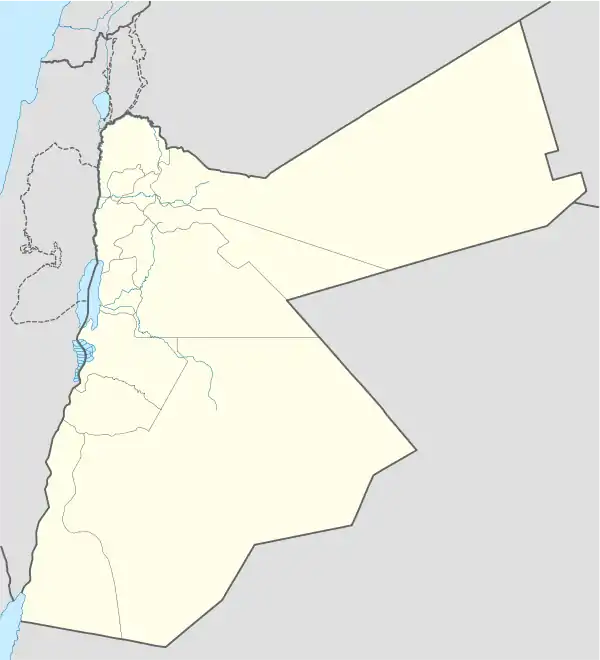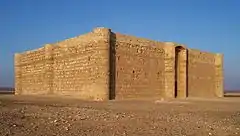Qasr Tuba
Qasr Tuba is an 8th-century Umayyad qasr or castle in the Amman Governorate of northern Jordan.
Qasr Tuba
قصر طوبة Qasr al-Tuba | |
|---|---|
 Qasr Tuba Location in Jordan | |
| Coordinates: 31°19′32″N 36°34′15″E | |
| Country | |
| Governorate | Amman Governorate |
| Time zone | UTC + 2 |
History
Qasr at-Tuba is the southernmost of the Umayyad desert castles in Jordan. Built in 743 CE by Caliph al-Walid II for his sons, al-Hakam and ‘Uthman,[1] it was initially intended to consist of two roughly 70-square-metre (750 sq ft) courtyard dwellings with projecting semicircular decorative towers, but the project was never completed.[2] The structure appears to have been abandoned some time after the assassination of Caliph al Walid.[3]

The palace at Qasr at-Tuba may have been the residence or hunting lodge of the Caliph's sons,[4] since hunting was a favoured pastime of the aristocracy.[5] It also served as a caravanserai and was part of the Caliph's program to improve the routes to Hijaz,[6] at a time when the number of caravans passing through the region had increased substantially.[7] It lacks the imperial features associated with other desert castles, suggesting that it was used as a temporary or seasonal residence rather than a permanent one.[8]
The site was brought to art historical attention after it was visited in 1896 by the Czech explorer Alois Musil.[9]
Description
It is situated about 110 kilometres (68 mi) south-east of the capital, Amman. Its location is relatively isolated, in a desert location and access can be difficult.[10] Most desert castles are located near to a source of water. Qasr al Tuba is no exception; wells are located nearby, close to a dry river bed ("wadi") and the site includes a dam and several wells.[11]
The surviving foundations and structures reveal its current layout as consisting of the west wing only; of an oblong enclosure measuring 140 by 72 metres (459 by 236 ft), almost a double square, or two symmetrical enclosures, each with a grand entrance, connected by an internal corridor, which could be cut off when necessary.[12] The enclosure walls are supported by semi-round towers, except on the north side where the two gateways are flanked by two square rooms. The northwestern section is nearly intact and several lengths of curtain-wall exist on the western side.[13] A prayer chapel has also been identified on the site.[14]
The surviving structures consist of ashlar masonry with baked brick and barrel-vaulted roofs. The lintels are decorated with rosettes, intertwined with plant leaves, which give the impression of fine lace work.[15]
It is a prime example of an Umayyad construction of brick vaults set on brick walls.[16] The Lonely Planet Guide describes it as "easily the most impressive of the lesser-known castles."[17]
References
- Hattstein, M. and Delius, P., Islam: Art and Architecture, Könemann, 2000. p. 72; Fowden, G., Qusayr 'Amra: Art and the Umayyad Elite in Late Antique Syria, University of California Press, 2004 p. 158
- Fowden, G., Qusayr 'Amra: Art and the Umayyad Elite in Late Antique Syria, University of California Press, 2004 p. 164-65
- Petersen, A, Dictionary of Islamic Architecture, Routledge, 2002, p. 239; Meyers, E.M. (ed.), The Oxford Encyclopedia of Archaeology in the Near East, Volume 5, Oxford University Press, 1997, p. 271
- Fowden, G., Qusayr 'Amra: Art and the Umayyad Elite in Late Antique Syria, University of California Press, 2004 p. 158; Hansen, I.L. and Wickham, C. (eds) The Long Eighth Century, BRILL, 2000, p. 289
- Petersen, A, Dictionary of Islamic Architecture, Routledge, 2002, p. 239; Meyers, E.M. (ed.), The Oxford Encyclopedia of Archaeology in the Near East, Volume 5, Oxford University Press, 1997, p. 241
- Hansen, I.L. and Wickham, C. (eds) The Long Eighth Century, BRILL, 2000, p. 289
- Jordan: Annual, Volume 36, Dāʼirat al-Āthār al-ʻĀmmah, 1992, p. 317 (translated from French)
- Hansen, I.L. and Wickham, C. (eds) The Long Eighth Century, BRILL, 2000, p. 290
- "Qasr Tuba | Jordan Travel Information and guide". Archived from the original on 2014-07-29. Retrieved 2009-12-04.
- Teller, M., Jordan,Rough Guides, 2002, p.4; Maplandia World Gazetteer
- Petersen, A, Dictionary of Islamic Architecture, Routledge, 2002, p. 239
- Rogers, M., The spread of Islam, Elsevier-Phaidon, 1976, p. 108
- Petersen, Andrew, Dictionary of Islamic Architecture, Routledge, 2002, p. 239
- حولية دائرة الآثار العامة, Volume 56, Jordan: Dāʼirat al-Āthār al-ʻĀmmah, Department of Antiquities, Hashemite Kingdom of Jordan, 2012, p. 57
- Talgamm T., The Stylistic Origins of Umayyad Sculpture and Architectural Decoration, Part 1, Otto Harrassowitz Verlag, 2004, p. 44
- Grabar, O., Holod, R., Knustad, J. and Trousdale, W, City in the Desert,Harvard CMES, 1978, p. 152
- "Jordan- Eastern Desert Attractions," Online: https://www.lonelyplanet.com/jordan/eastern-desert/attractions/qasr-al-tuba/a/poi-sig/1106901/361086
External links
Further reading
- Jonathan Bloom and Sheila Blair (eds), Grove Encyclopedia of Islamic Art & Architecture, [Three-Volume Set], Oxford University Press, 2009

